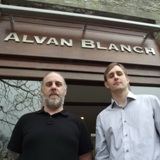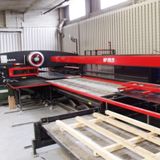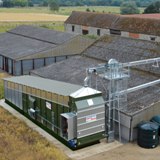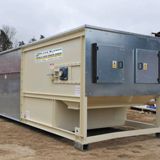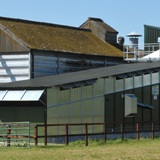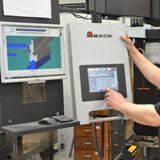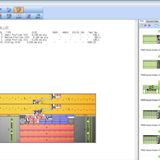 Radbend Goes With the Grain For Crop Processing Machines
Radbend Goes With the Grain For Crop Processing Machines
A company manufacturing crop processing machines eradicated a production bottleneck by driving four press brakes with Radbend software.
When CAD/CAM engineer Graham Robbins joined Alvan Blanch two years ago the press brakes were programmed manually. “Although the operators are highly skilled they still needed time when working on new components to look at engineering drawings, deciding on the tooling and calculating bend sequences. It was quite a bottleneck.”
“Initial results are extremely encouraging; both from material usage and time spent creating the nests. RADAN is absolutely fundamental to what we do. We just couldn’t work without it now.”
CAD CAM engineer, Graham Robbins
One of his first tasks was to address that, and the powerful Radbend module from RADAN now controls four Amadas – an HFE 8025, HFE 220-4, HFE M2 170-4 and HFE M2 100-3.
“We’ve put mini PCs on the press brake controllers, and with Radbend Viewer linked to the server the operators can interrogate the 3D model, rotate the part and query anything at the machine. They also see a full animation of how the part should be fed in, along with its orientation and step-by-step of each fold.”
With Radbend automatically calculating everything the operator needs to know, engineering drawings are only used as backup now, rather than being a necessity. All the information is readily available in 3D by pulling up the program on the mini PCs.
Alvan Blanch is a British manufacturing and project engineering company with a global outlook, specialising in the design, production and supply of quality machines and integrated systems for the primary and secondary processing of agricultural produce and waste materials. Typical products provide processes for grain drying, grain cleaning, fruit processing, vegetable oil processing, feed milling, rice processing, harvesting equipment, environmental and organic waste processes.
Design Manager Tim Baker says their larger machines comprise around 300 components, with approximately 100 parts in each of the smaller threshers and roller mills. As well as Radbend, Alvan Blanch have a number of other RADAN modules, including Radraft, Radprofile, Radpunch, Radnest, RADAN 3D and e2i. “Every sheetmetal component goes through RADAN, and the accuracy of the files is extremely important, as customers are demanding ever-faster turnaround, so we don’t have time to deal with parts that are wrong.”
As Radpunch drives their Amada EM 2510 NT punch press, and Radprofile programs an Amada LC 4020 F1 NT 4m x 2m-bed 4kW laser cutter, Graham Robbins says it is extremely easy to switch a part from one machine to the other. “For instance, if other parts take priority on the laser it’s simple to retool a component and produce a punch program.”
He says after components are designed in Autodesk Inventor, they use DTM software from RADAN to take the 3D model and package it into one file containing both the 3D and 2D information. “The factory operators who do the nesting take the DTM file – which automatically unfolds the model – and extract the 3D element for use with Radbend to produce programs for the presses. The 2D aspect is used to create the symbols that are processed for the laser or punch.”
Once in the part environment, they tool it and transfer it to e2i for material costings, machine run-time and folding costs. “The information then goes into Sage to produce a Bill of Materials, before being released for production.”
Shop floor based production planners and managers decide which cutting technology to use, depending on the metal thickness required and the workload of each machine. They then create the nests, including nesting multiple jobs based on the type and thickness of material. “Generally, rectangles and simple shapes go on the punch, with anything more complicated and in thicker material being laser cut.”
Since introducing project nesting recently, they have reduced the scrap of their mild, galvanised and stainless steel by around 20 per cent. “Initial results are extremely encouraging; both from material usage and time spent creating the nests. RADAN is absolutely fundamental to what we do. We just couldn’t work without it now.”
A combination of RADAN and an MP 300/40 auto loader means the punch can produce certain components, unmanned, throughout the night. “Our driers contain a number of louvred panels which are a very simple shape, and we need a lot of them. So with the nests created in RADAN, we set up a stack of sheet metal, and come back in the morning to the cut parts.”
The factory, in Malmesbury, Wiltshire, has capacity to concurrently produce 16 driers, each approximately 20 metres x 4 metres, and there are plans to expand. Export has played an important role since the company was founded in the 1950s, making up around 80 percent of their turnover, and they hold the Queen’s Award for Overseas Trade. Tim Baker says: “Manufacturing in the UK must be globally competitive to be able to win this level of overseas business. Investment initiatives in systems and technology, such as RADAN and the other many investments that Alvan Blanch have made in the last three years, has been a major part of our current growth strategy which has led to a £10M turnover for last year.”
About the Company
Name: Alvan Blanch
Benefits Achieved
- All information is now readily available
- 20% less scrap metal
- Able to produce certain components overnight
Comments
"Initial results are extremely encouraging; both from material usage and time spent creating the nests. RADAN is absolutely fundamental to what we do. We just couldn’t work without it now."
CAD CAM engineer, Graham Robbins









